Canadian vs Nicaraguan Community Comparison
COMPARE
Canadian
Nicaraguan
Social Comparison
Social Comparison
Canadians
Nicaraguans
7,303
SOCIAL INDEX
70.5/ 100
SOCIAL RATING
123rd/ 347
SOCIAL RANK
3,542
SOCIAL INDEX
32.9/ 100
SOCIAL RATING
217th/ 347
SOCIAL RANK
Nicaraguan Integration in Canadian Communities
The statistical analysis conducted on geographies consisting of 253,207,355 people shows a substantial positive correlation between the proportion of Nicaraguans within Canadian communities in the United States with a correlation coefficient (R) of 0.539. On average, for every 1% (one percent) increase in Canadians within a typical geography, there is an increase of 0.299% in Nicaraguans. To illustrate, in a geography comprising of 100,000 individuals, a rise of 1,000 Canadians corresponds to an increase of 298.6 Nicaraguans.
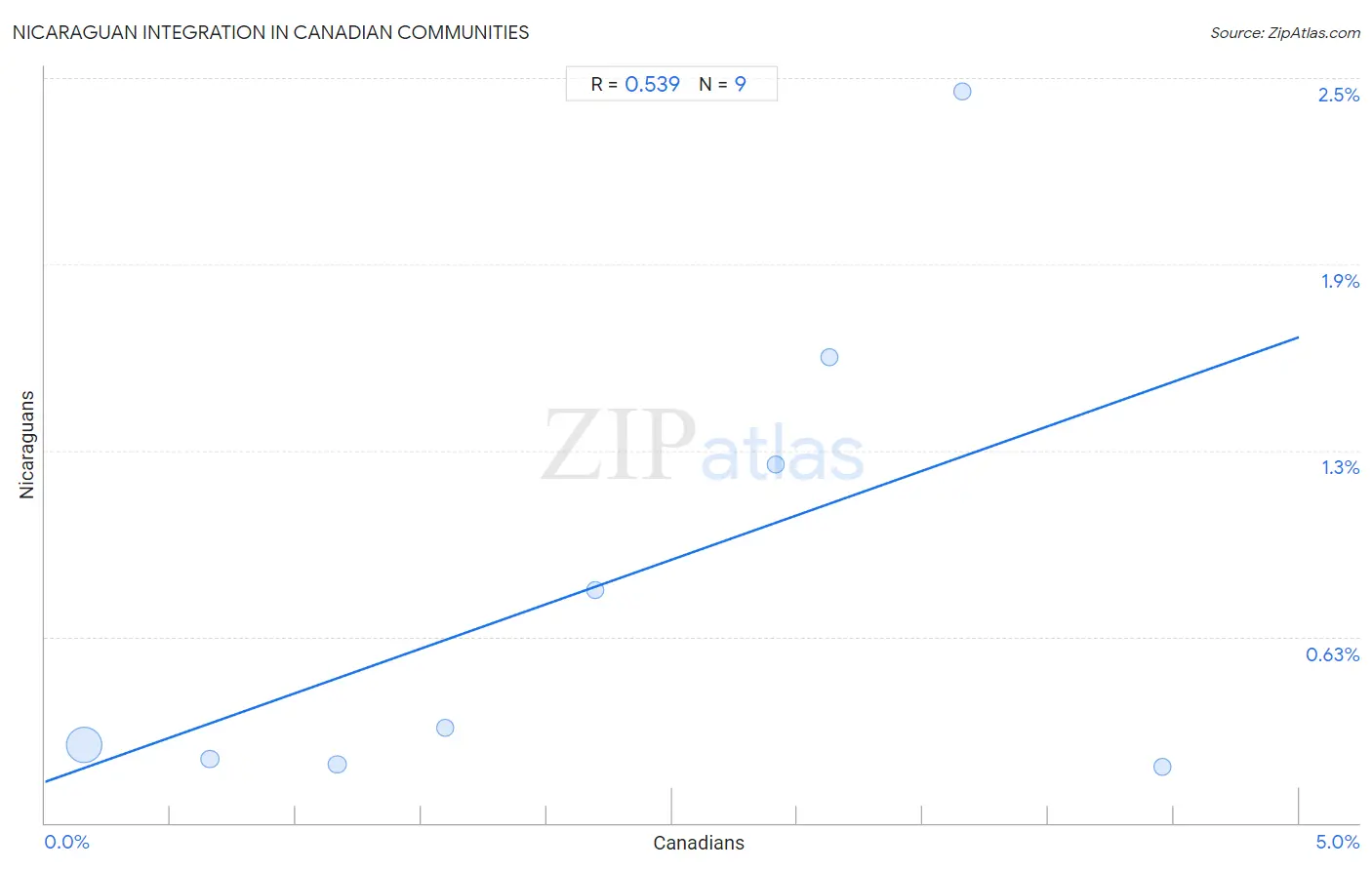
Canadian vs Nicaraguan Income
When considering income, the most significant differences between Canadian and Nicaraguan communities in the United States are seen in wage/income gap (28.1% compared to 23.4%, a difference of 20.1%), per capita income ($45,858 compared to $39,372, a difference of 16.5%), and median male earnings ($57,286 compared to $49,215, a difference of 16.4%). Conversely, both communities are more comparable in terms of householder income under 25 years ($52,336 compared to $53,275, a difference of 1.8%), median female earnings ($39,724 compared to $36,904, a difference of 7.6%), and median household income ($87,769 compared to $79,737, a difference of 10.1%).

| Income Metric | Canadian | Nicaraguan |
| Per Capita Income | Exceptional $45,858 | Tragic $39,372 |
| Median Family Income | Excellent $106,597 | Tragic $92,231 |
| Median Household Income | Excellent $87,769 | Tragic $79,737 |
| Median Earnings | Excellent $47,911 | Tragic $43,026 |
| Median Male Earnings | Exceptional $57,286 | Tragic $49,215 |
| Median Female Earnings | Average $39,724 | Tragic $36,904 |
| Householder Age | Under 25 years | Average $52,336 | Exceptional $53,275 |
| Householder Age | 25 - 44 years | Excellent $97,625 | Tragic $87,751 |
| Householder Age | 45 - 64 years | Excellent $104,560 | Tragic $92,554 |
| Householder Age | Over 65 years | Good $62,230 | Tragic $54,474 |
| Wage/Income Gap | Tragic 28.1% | Exceptional 23.4% |
Canadian vs Nicaraguan Poverty
When considering poverty, the most significant differences between Canadian and Nicaraguan communities in the United States are seen in receiving food stamps (10.5% compared to 16.1%, a difference of 53.1%), seniors poverty over the age of 65 (9.9% compared to 15.0%, a difference of 51.2%), and seniors poverty over the age of 75 (11.3% compared to 16.6%, a difference of 47.5%). Conversely, both communities are more comparable in terms of single female poverty (21.1% compared to 21.3%, a difference of 1.2%), single mother poverty (29.3% compared to 29.8%, a difference of 1.9%), and female poverty among 25-34 year olds (13.6% compared to 14.5%, a difference of 6.5%).
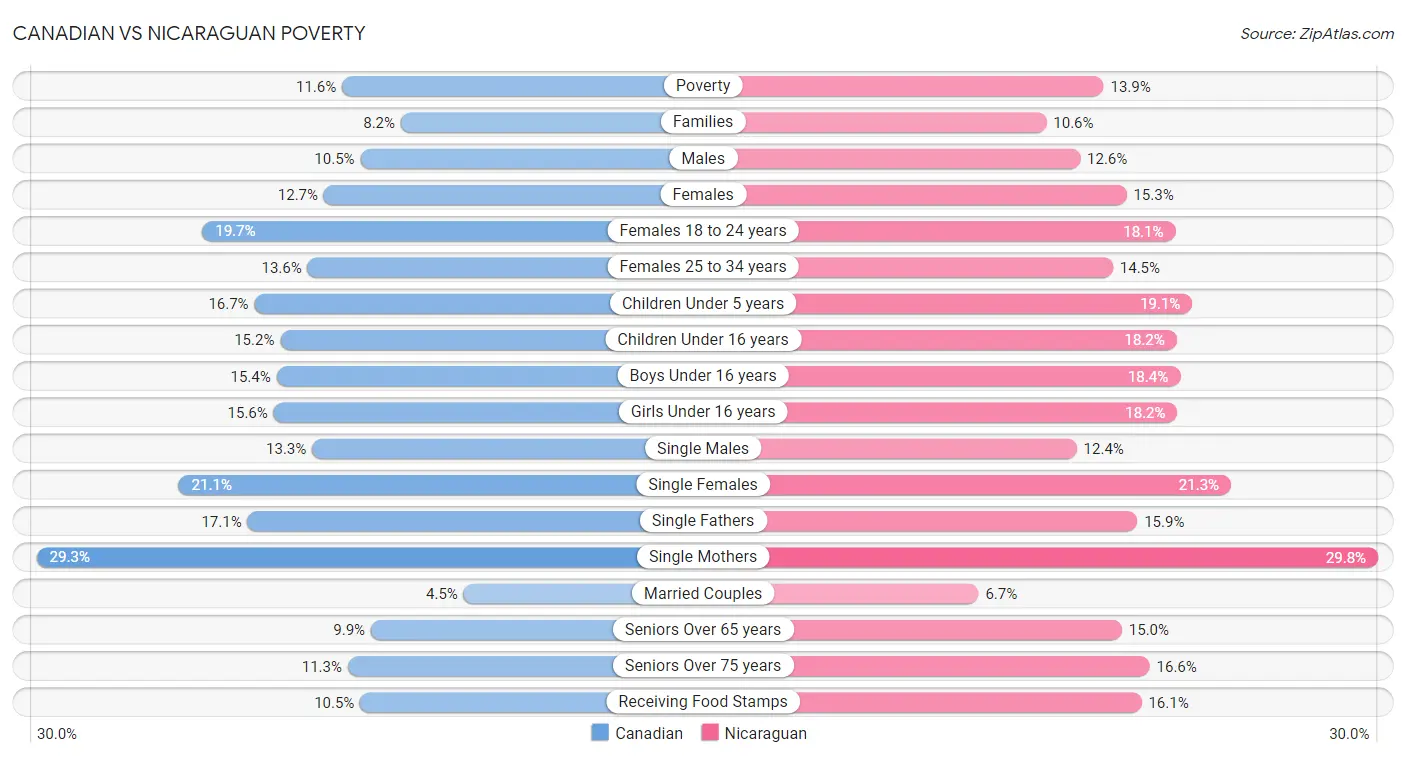
| Poverty Metric | Canadian | Nicaraguan |
| Poverty | Exceptional 11.6% | Tragic 13.9% |
| Families | Exceptional 8.2% | Tragic 10.6% |
| Males | Exceptional 10.5% | Tragic 12.6% |
| Females | Exceptional 12.7% | Tragic 15.3% |
| Females 18 to 24 years | Excellent 19.7% | Exceptional 18.1% |
| Females 25 to 34 years | Average 13.6% | Tragic 14.5% |
| Children Under 5 years | Good 16.7% | Tragic 19.1% |
| Children Under 16 years | Excellent 15.2% | Tragic 18.2% |
| Boys Under 16 years | Exceptional 15.4% | Tragic 18.4% |
| Girls Under 16 years | Excellent 15.6% | Tragic 18.2% |
| Single Males | Tragic 13.3% | Exceptional 12.4% |
| Single Females | Average 21.1% | Fair 21.3% |
| Single Fathers | Tragic 17.1% | Exceptional 15.9% |
| Single Mothers | Average 29.3% | Poor 29.8% |
| Married Couples | Exceptional 4.5% | Tragic 6.7% |
| Seniors Over 65 years | Exceptional 9.9% | Tragic 15.0% |
| Seniors Over 75 years | Exceptional 11.3% | Tragic 16.6% |
| Receiving Food Stamps | Exceptional 10.5% | Tragic 16.1% |
Canadian vs Nicaraguan Unemployment
When considering unemployment, the most significant differences between Canadian and Nicaraguan communities in the United States are seen in unemployment among seniors over 75 years (9.7% compared to 8.2%, a difference of 18.8%), female unemployment (5.0% compared to 5.5%, a difference of 9.7%), and unemployment among women with children under 6 years (7.8% compared to 7.2%, a difference of 8.1%). Conversely, both communities are more comparable in terms of unemployment among women with children ages 6 to 17 years (9.4% compared to 9.4%, a difference of 0.23%), unemployment among ages 30 to 34 years (5.5% compared to 5.6%, a difference of 0.92%), and unemployment among youth under 25 years (11.4% compared to 11.3%, a difference of 0.99%).
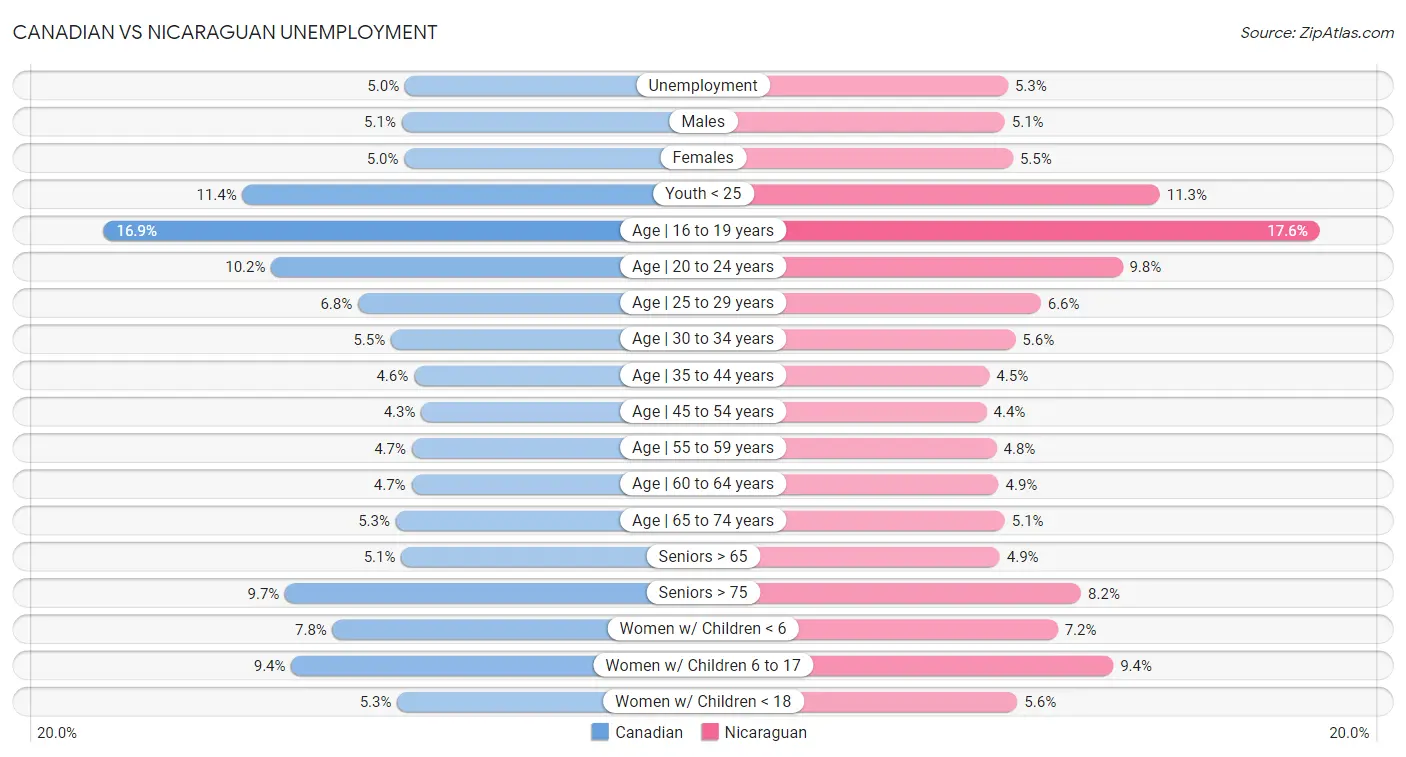
| Unemployment Metric | Canadian | Nicaraguan |
| Unemployment | Exceptional 5.0% | Average 5.3% |
| Males | Exceptional 5.1% | Excellent 5.1% |
| Females | Exceptional 5.0% | Tragic 5.5% |
| Youth < 25 | Excellent 11.4% | Exceptional 11.3% |
| Age | 16 to 19 years | Exceptional 16.9% | Average 17.6% |
| Age | 20 to 24 years | Good 10.2% | Exceptional 9.8% |
| Age | 25 to 29 years | Poor 6.8% | Good 6.6% |
| Age | 30 to 34 years | Fair 5.5% | Fair 5.6% |
| Age | 35 to 44 years | Good 4.6% | Excellent 4.5% |
| Age | 45 to 54 years | Exceptional 4.3% | Excellent 4.4% |
| Age | 55 to 59 years | Exceptional 4.7% | Average 4.8% |
| Age | 60 to 64 years | Exceptional 4.7% | Fair 4.9% |
| Age | 65 to 74 years | Good 5.3% | Exceptional 5.1% |
| Seniors > 65 | Good 5.1% | Exceptional 4.9% |
| Seniors > 75 | Tragic 9.7% | Exceptional 8.2% |
| Women w/ Children < 6 | Fair 7.8% | Exceptional 7.2% |
| Women w/ Children 6 to 17 | Tragic 9.4% | Tragic 9.4% |
| Women w/ Children < 18 | Excellent 5.3% | Poor 5.6% |
Canadian vs Nicaraguan Labor Participation
When considering labor participation, the most significant differences between Canadian and Nicaraguan communities in the United States are seen in in labor force | age 16-19 (40.1% compared to 32.4%, a difference of 23.7%), in labor force | age 20-24 (76.6% compared to 73.2%, a difference of 4.7%), and in labor force | age 25-29 (84.7% compared to 83.1%, a difference of 1.9%). Conversely, both communities are more comparable in terms of in labor force | age 35-44 (84.2% compared to 84.1%, a difference of 0.10%), in labor force | age 20-64 (79.1% compared to 79.3%, a difference of 0.22%), and in labor force | age 45-54 (82.4% compared to 82.8%, a difference of 0.38%).

| Labor Participation Metric | Canadian | Nicaraguan |
| In Labor Force | Age > 16 | Tragic 64.1% | Average 65.1% |
| In Labor Force | Age 20-64 | Tragic 79.1% | Poor 79.3% |
| In Labor Force | Age 16-19 | Exceptional 40.1% | Tragic 32.4% |
| In Labor Force | Age 20-24 | Exceptional 76.6% | Tragic 73.2% |
| In Labor Force | Age 25-29 | Average 84.7% | Tragic 83.1% |
| In Labor Force | Age 30-34 | Poor 84.4% | Tragic 83.9% |
| In Labor Force | Age 35-44 | Poor 84.2% | Poor 84.1% |
| In Labor Force | Age 45-54 | Poor 82.4% | Average 82.8% |
Canadian vs Nicaraguan Family Structure
When considering family structure, the most significant differences between Canadian and Nicaraguan communities in the United States are seen in single mother households (5.9% compared to 7.2%, a difference of 22.2%), single father households (2.3% compared to 2.6%, a difference of 15.8%), and births to unmarried women (31.9% compared to 36.6%, a difference of 14.6%). Conversely, both communities are more comparable in terms of family households (64.4% compared to 67.4%, a difference of 4.5%), family households with children (27.1% compared to 28.4%, a difference of 4.8%), and divorced or separated (12.4% compared to 13.0%, a difference of 5.2%).

| Family Structure Metric | Canadian | Nicaraguan |
| Family Households | Good 64.4% | Exceptional 67.4% |
| Family Households with Children | Tragic 27.1% | Exceptional 28.4% |
| Married-couple Households | Exceptional 48.2% | Tragic 45.2% |
| Average Family Size | Tragic 3.14 | Exceptional 3.36 |
| Single Father Households | Good 2.3% | Tragic 2.6% |
| Single Mother Households | Exceptional 5.9% | Tragic 7.2% |
| Currently Married | Exceptional 48.3% | Tragic 44.2% |
| Divorced or Separated | Tragic 12.4% | Tragic 13.0% |
| Births to Unmarried Women | Average 31.9% | Tragic 36.6% |
Canadian vs Nicaraguan Vehicle Availability
When considering vehicle availability, the most significant differences between Canadian and Nicaraguan communities in the United States are seen in no vehicles in household (8.3% compared to 9.7%, a difference of 16.0%), 2 or more vehicles in household (58.6% compared to 56.1%, a difference of 4.4%), and 1 or more vehicles in household (91.8% compared to 90.4%, a difference of 1.5%). Conversely, both communities are more comparable in terms of 3 or more vehicles in household (21.0% compared to 20.7%, a difference of 1.5%), 4 or more vehicles in household (6.9% compared to 7.0%, a difference of 1.5%), and 1 or more vehicles in household (91.8% compared to 90.4%, a difference of 1.5%).

| Vehicle Availability Metric | Canadian | Nicaraguan |
| No Vehicles Available | Exceptional 8.3% | Excellent 9.7% |
| 1+ Vehicles Available | Exceptional 91.8% | Excellent 90.4% |
| 2+ Vehicles Available | Exceptional 58.6% | Good 56.1% |
| 3+ Vehicles Available | Exceptional 21.0% | Exceptional 20.7% |
| 4+ Vehicles Available | Exceptional 6.9% | Exceptional 7.0% |
Canadian vs Nicaraguan Education Level
When considering education level, the most significant differences between Canadian and Nicaraguan communities in the United States are seen in no schooling completed (1.7% compared to 2.9%, a difference of 75.7%), doctorate degree (2.0% compared to 1.5%, a difference of 32.8%), and master's degree (15.7% compared to 12.5%, a difference of 25.8%). Conversely, both communities are more comparable in terms of nursery school (98.4% compared to 97.1%, a difference of 1.4%), kindergarten (98.4% compared to 97.0%, a difference of 1.4%), and 1st grade (98.3% compared to 97.0%, a difference of 1.4%).
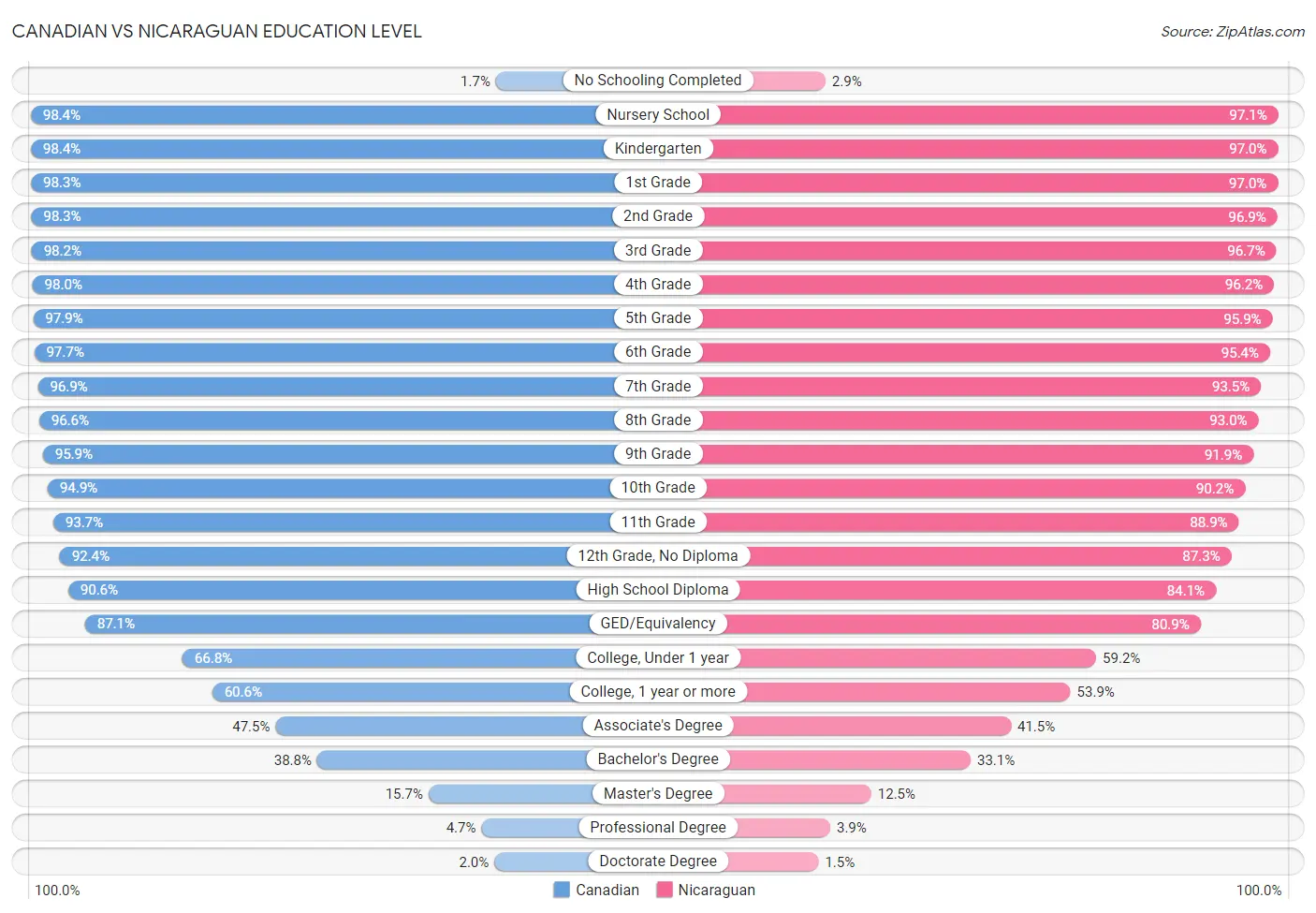
| Education Level Metric | Canadian | Nicaraguan |
| No Schooling Completed | Exceptional 1.7% | Tragic 2.9% |
| Nursery School | Exceptional 98.4% | Tragic 97.1% |
| Kindergarten | Exceptional 98.4% | Tragic 97.0% |
| 1st Grade | Exceptional 98.3% | Tragic 97.0% |
| 2nd Grade | Exceptional 98.3% | Tragic 96.9% |
| 3rd Grade | Exceptional 98.2% | Tragic 96.7% |
| 4th Grade | Exceptional 98.0% | Tragic 96.2% |
| 5th Grade | Exceptional 97.9% | Tragic 95.9% |
| 6th Grade | Exceptional 97.7% | Tragic 95.4% |
| 7th Grade | Exceptional 96.9% | Tragic 93.5% |
| 8th Grade | Exceptional 96.6% | Tragic 93.0% |
| 9th Grade | Exceptional 95.9% | Tragic 91.9% |
| 10th Grade | Exceptional 94.9% | Tragic 90.2% |
| 11th Grade | Exceptional 93.7% | Tragic 88.9% |
| 12th Grade, No Diploma | Exceptional 92.4% | Tragic 87.3% |
| High School Diploma | Exceptional 90.6% | Tragic 84.1% |
| GED/Equivalency | Exceptional 87.1% | Tragic 80.9% |
| College, Under 1 year | Excellent 66.8% | Tragic 59.2% |
| College, 1 year or more | Excellent 60.6% | Tragic 53.9% |
| Associate's Degree | Good 47.5% | Tragic 41.5% |
| Bachelor's Degree | Good 38.8% | Tragic 33.1% |
| Master's Degree | Excellent 15.7% | Tragic 12.5% |
| Professional Degree | Excellent 4.7% | Tragic 3.9% |
| Doctorate Degree | Exceptional 2.0% | Tragic 1.5% |
Canadian vs Nicaraguan Disability
When considering disability, the most significant differences between Canadian and Nicaraguan communities in the United States are seen in disability age under 5 (1.5% compared to 1.1%, a difference of 28.4%), hearing disability (3.5% compared to 2.7%, a difference of 28.1%), and disability age 18 to 34 (7.3% compared to 5.8%, a difference of 25.0%). Conversely, both communities are more comparable in terms of cognitive disability (16.8% compared to 17.0%, a difference of 0.78%), ambulatory disability (6.3% compared to 6.1%, a difference of 3.5%), and disability age over 75 (46.6% compared to 48.3%, a difference of 3.6%).
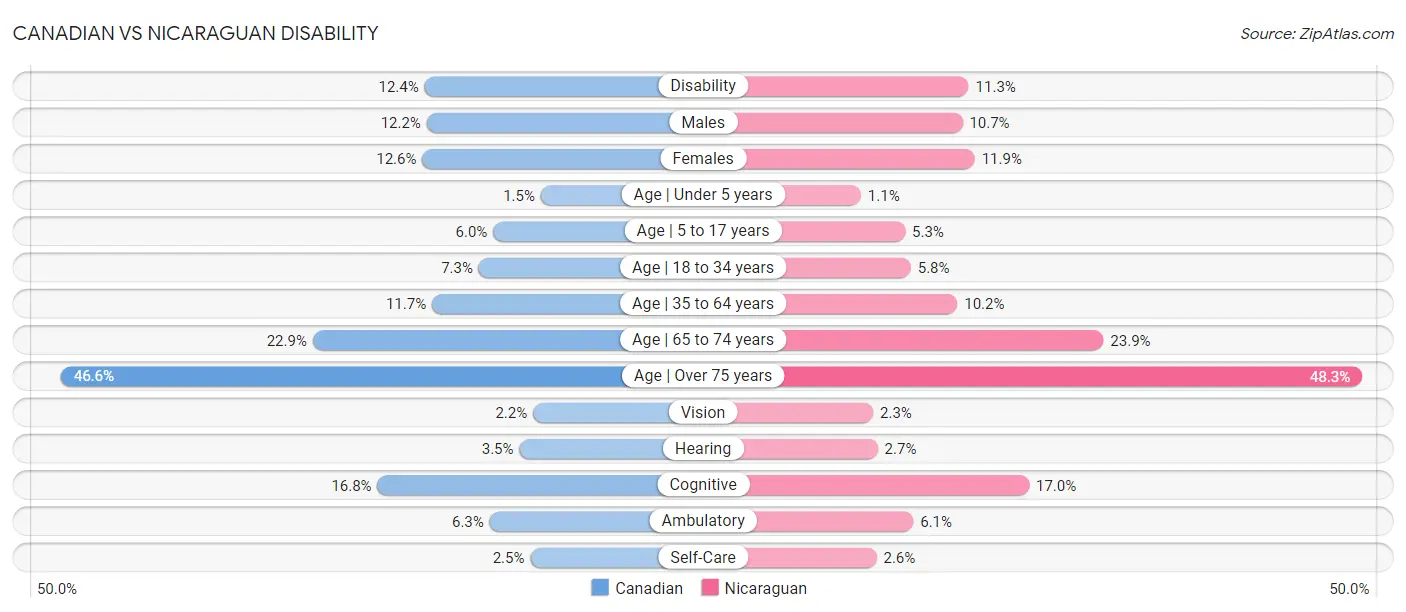
| Disability Metric | Canadian | Nicaraguan |
| Disability | Tragic 12.4% | Exceptional 11.3% |
| Males | Tragic 12.2% | Exceptional 10.7% |
| Females | Tragic 12.6% | Exceptional 11.9% |
| Age | Under 5 years | Tragic 1.5% | Exceptional 1.1% |
| Age | 5 to 17 years | Tragic 6.0% | Exceptional 5.3% |
| Age | 18 to 34 years | Tragic 7.3% | Exceptional 5.8% |
| Age | 35 to 64 years | Poor 11.7% | Exceptional 10.2% |
| Age | 65 to 74 years | Good 22.9% | Poor 23.9% |
| Age | Over 75 years | Exceptional 46.6% | Tragic 48.3% |
| Vision | Fair 2.2% | Tragic 2.3% |
| Hearing | Tragic 3.5% | Exceptional 2.7% |
| Cognitive | Exceptional 16.8% | Exceptional 17.0% |
| Ambulatory | Poor 6.3% | Good 6.1% |
| Self-Care | Average 2.5% | Tragic 2.6% |